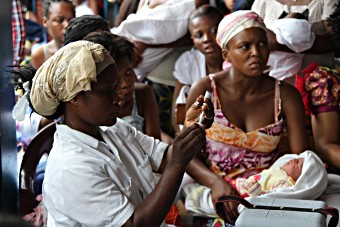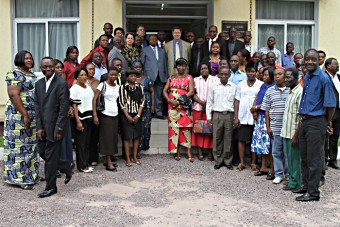
Mother and Child Center of Barumbu, Kinshasa
Source: GAVI2012/John Bompengo
Kinshasa, 14 December 2012 - The Democratic Republic of Congo (DR Congo) is one of the largest recipients of funds from the GAVI Alliance, yet “we know that there are immunisation gaps because various epidemics continue to occur. Despite dramatic efforts, 20-30% of children are still not reached,” stressed Dr Seth Berkley, GAVI CEO, during his first visit to the country.
“GAVI supports the DR Congo in its routine immunisation efforts because that’s fundamental to protecting all children from disease.”
The twofold objective of Dr Berkley’s visit to Central Africa’s giant was to gain a better understanding of what drives increases in immunisation coverage in a large fragile country and to advise on the scaling-up of pneumococcal vaccines.
Meetings with various partners, including government ministers, UNICEF, the World Health Organization (WHO) and DR Congo's vibrant civil society allowed vigorous discussion of how best to provide financial sustainability for immunisation.
Providing all children with the vaccines they need in a large fragile country

GAVI CEO Dr Seth Berkley pictured with Dr Félix Kabange Numbi, DR Congo minister of health, staff and partners at the Expanded Programme for Immunisation building in Kinshasa.
Even though the DR Congo is not on track to reach the Millennium Development Goals, it has made progress in child mortality: today, 158 out of 1,000 children die before their fifth birthday and, although still very high, this figure shows a positive trend compared to 2001, when 213 children did not reach the age of five years.
Equity and access continue to be major challenges. A 2010 UNICEF study conducted in DR Congo noted that for every four fully vaccinated children in socio-economically well-off families, there is just one fully vaccinated child in a disadvantaged household.
Since GAVI began its support to DR Congo in 2003, the country has more than doubled its routine immunisation coverage to nearly 80% for diphtheria, tetanus and whopping cough.
“With over US$ 292 million approved until 2016, DR Congo is the second highest funded country in sub-Saharan Africa and we greatly appreciated this support for our children’s health,” said Dr Félix Kabange Numbi, Minister of Public Health.
“GAVI believes that the participation of governments in funding vaccines is essential and we are pleased that the Government of DR Congo has committed to keep up its share,” Dr Seth Berkley said.
GAVI’s co-financing policy requires low-income countries to fund a portion of the cost of vaccines themselves to ensure that countries can eventually sustain their immunisation programmes without external support.
“New vaccines are expensive and a contribution of the government is vital,” explained Dr Jean Marie Okwo Bele, head of immunisation at WHO Geneva. “At the global level, WHO is committed to identifying special funding to support the efforts of DR Congo over the coming three years.”
Geographic challenges
With over US$ 292 million approved until 2016, DR Congo is the second highest funded country in sub-Saharan Africa and we greatly appreciated this support for our children’s health
Dr Félix Kabange Numbi, Minister of Public Health of the Democratic Republic of Congo
At 2.3 million square kilometres, DR Congo is the second biggest African country. Impassable roads, rivers and mountains divide much of the country’s population of 70 million, making transportation a challenging and expensive enterprise.
Life-saving vaccinations can only be delivered by plane to provincial health centres. They are dispatched to villages by car, motorcycle, boat and bicycle, or transported by foot in a vaccine cooler. Once they arrive at their destination, the vaccines are at risk of spoiling because of power outages and ageing refrigeration equipment.
This is where GAVI’s support is key to secure supplies and strengthen the cold chain, as well as improving health systems.
In April 2011, DRC introduced, with GAVI support, a new pneumococcal vaccine to combat the primary cause of pneumonia. The vaccine is now being used in five provinces and scale-up is planned by the EPI for 2013.
“The EPI is the backbone of the national health system. It allows providing all children with the vaccines they need and have the right to get,” said Barbara Bentein, UNICEF Representative in DR Congo. “We work with the Government and our partners to fight epidemics. Vaccine supply, cold chain support and mass distributions of bednets are combined with large-scale social mobilization campaigns to rally communities for the health of their children.”

Dr Berkley meets with DR Congo Prime Minister, Augustin Matata Ponyo and partners.
To achieve long-lasting impact the responsibility must be shifted back to those who are at the frontlines.
“We must plan and implement vaccination with decision-makers in the places where the epidemics occur. They know the context best,” underlined Dr Pierre Lokadi Otete Opetha, Secretary General of the Health Ministry. “Players at all levels must acknowledge their accountability for results and the transparent use of resources.”
Congratulating the vaccination partners on the high quality of planning and evaluation in the past, Dr Berkley commented, “Vaccines are tangible and measurable. By showing value for money, our chances are good to sustain funding even in times of financial shortages.”
From 2013, DR Congo will be part of GAVI’s new, tailored approach to countries with specific needs. Among the core priorities are measles and pneumonia, as measles outbreaks were reported in ten out of 11 provinces resulting in over 41,000 cases and 1,100 deaths by the end September 2012.
The Minister of Health called for a sustained effort.
“The challenges to reach every single child with vaccination are massive. But by working together we can save the lives of our children.”

 UNICEF's Cornelia Walther reports on why the Democratic Republic of Congo is a focus country for GAVI’s new, tailored approach to countries with specific needs.
UNICEF's Cornelia Walther reports on why the Democratic Republic of Congo is a focus country for GAVI’s new, tailored approach to countries with specific needs.